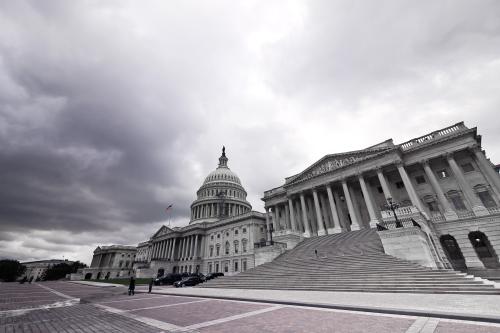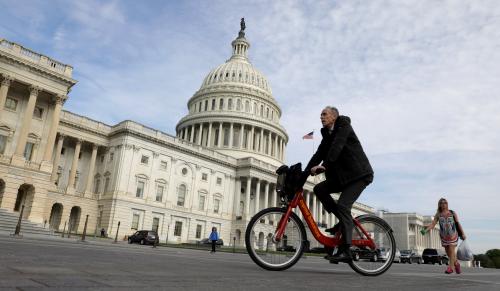Introduction
In light of recent economic trends and the most recent Congressional Budget Office projections (CBO 2024), we offer new perspectives on the medium- and long-term fiscal outlook, updating our previous work, most recently in Auerbach and Gale (2023a and 2023b).
The basic story is familiar. Low revenues, coupled with rising outlays on health-related programs and Social Security, drive permanent, rising primary deficits as a share of the economy. Net interest payments also rise substantially relative to GDP due to high pre-existing debt, rising primary deficits, and gradually increasing interest rates. Unified deficits and public debt rise accordingly.
Under current law for the next 10 years, the CBO’s projections imply that persistent primary deficits will average 2.1% of GDP. Net interest payments will rise from 2.4% of GDP currently to 3.9% in 2034, which would represent an all-time high. The unified deficit and even the cyclically adjusted deficit will approach 6% of GDP within 10 years. Debt will rise from 97% of GDP currently to 116% by 2034, another all-time high.
Over the following two decades, the projected trends are even less auspicious. Primary deficits rise further as spending on Social Security and health-related programs continues to grow much faster as a share of GDP than revenues do. The average nominal interest rate on government debt rises to exceed the nominal economic growth rate by 2041, setting off the possibility of explosive debt dynamics. By 2054, relative to GDP, annual net interest payments exceed 6.4%, the unified deficit exceeds 9%, and the public debt stands at 172%. All these figures would be all-time highs (except for deficits during World War II, the 2008 financial crisis, and in the first two years of the COVID-19 pandemic) and would continue to grow after 2054.
Budget outcomes would be even worse under “current-policy” projections that incorporate more realistic policy choices than those required by the baseline calculations. Making temporary tax provisions—such as those in the Tax Cut and Jobs Act of 2017—permanent and making plausible assumptions about future discretionary spending would drive the debt-to-GDP ratio to 211% by 2054.
Fiscal gap calculations indicate the magnitude of the changes required to meet a future fiscal target. For example, starting from the current-law baseline, we estimate that to keep the debt-to-GDP ratio at its current level (97%) in 2054 would require a combination of permanent spending cuts or tax increases equaling 2.37% of GDP if implemented starting in 2025. This represents about $668 billion in today’s economy, or about 27% of current income tax revenues, 14% of all current tax revenues, 12% of current non-interest spending, or 20% of current non-interest spending other than Social Security and Medicare. Delaying the implementation of the actions would raise the size of the intervention needed.
The 10-year fiscal outlook has improved slightly over the past year, in part because of the recent Fiscal Responsibility Act (FRA) of 2023 (i.e., the debt ceiling deal), which reduced the projected cumulative deficit from 2023 to 2032 by $1.3 trillion (CBO 2023e), and despite slightly higher projected interest rates. The long-term fiscal outlook has also improved, with the 2053 debt-to-GDP ratio falling from 195% last year to about 168% in the current projection under current law. The reduction in the long-term shortfall is due to lower projected Medicare spending and the FRA (CBO 2023b).
Long-term budget projections, of course, are sensitive to parameter choices in general, and to interest rate projections in particular. But it would take enormous and unlikely favorable variation from baseline parameters to put fiscal policy on a sustainable course.
Section II describes the construction of different budget baselines. Section III summarizes how projections for gross domestic product (GDP) and interest rates have changed over the past year. Section IV examines the 10- and 30-year current-law budget projections as of February 2024 and compares them to the May 2023 baseline. Section V estimates the effects of current-policy adjustments relative to current law. Section VI discusses cyclically adjusted deficits and sensitivity analysis. Section VII calculates fiscal gaps under various scenarios. Section VIII concludes with a discussion of a variety of perspectives on and interpretations of the budget outlook.
-
Acknowledgements and disclosures
The authors thank Oliver Hall for research assistance and Joshua Gotbaum for helpful comments. Gale thanks Arnold Ventures and the California Community Foundation for generous research support. The views expressed here are solely those of the authors and should not be attributed to any other person or any organization.
The Brookings Institution is financed through the support of a diverse array of foundations, corporations, governments, individuals, as well as an endowment. A list of donors can be found in our annual reports published online here. The findings, interpretations, and conclusions in this report are solely those of its author(s) and are not influenced by any donation.
The Brookings Institution is committed to quality, independence, and impact.
We are supported by a diverse array of funders. In line with our values and policies, each Brookings publication represents the sole views of its author(s).







